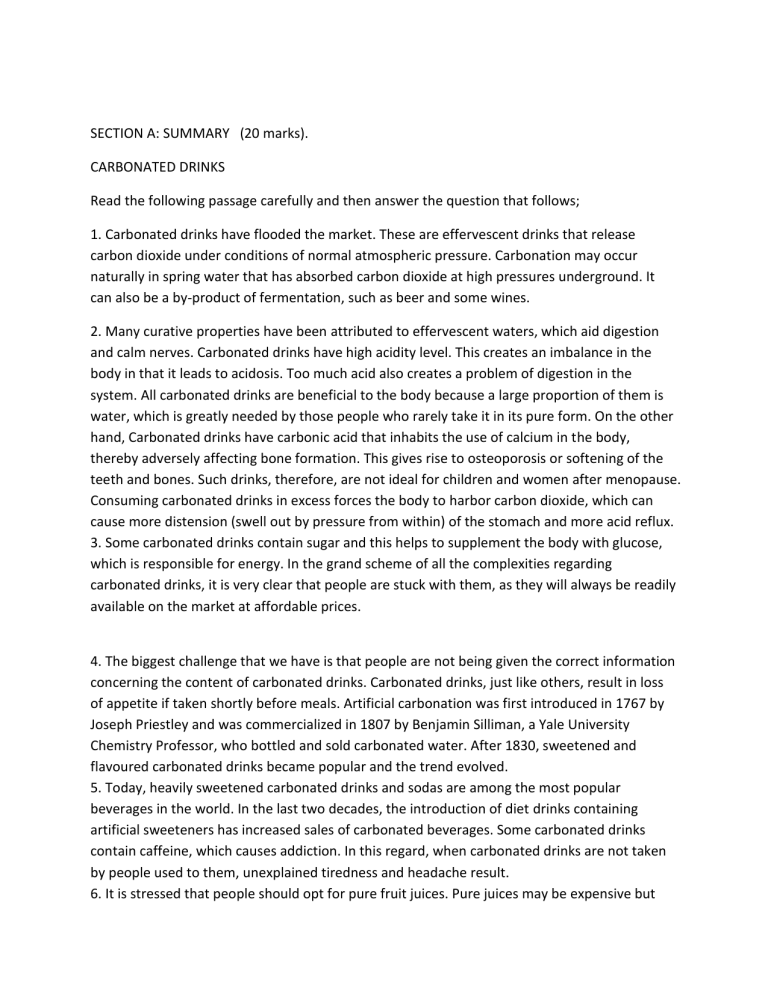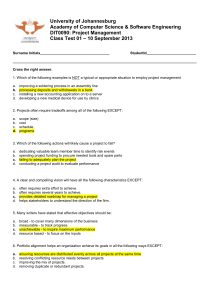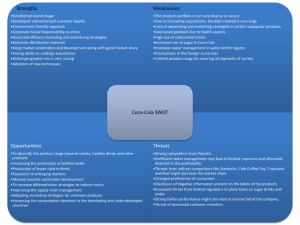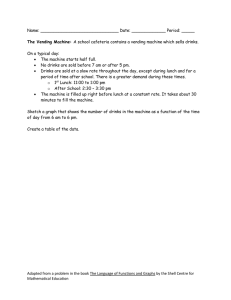Carbonated Drinks Exam Paper: Summary, Structure, Composition
advertisement

SECTION A: SUMMARY (20 marks). CARBONATED DRINKS Read the following passage carefully and then answer the question that follows; 1. Carbonated drinks have flooded the market. These are effervescent drinks that release carbon dioxide under conditions of normal atmospheric pressure. Carbonation may occur naturally in spring water that has absorbed carbon dioxide at high pressures underground. It can also be a by-product of fermentation, such as beer and some wines. 2. Many curative properties have been attributed to effervescent waters, which aid digestion and calm nerves. Carbonated drinks have high acidity level. This creates an imbalance in the body in that it leads to acidosis. Too much acid also creates a problem of digestion in the system. All carbonated drinks are beneficial to the body because a large proportion of them is water, which is greatly needed by those people who rarely take it in its pure form. On the other hand, Carbonated drinks have carbonic acid that inhabits the use of calcium in the body, thereby adversely affecting bone formation. This gives rise to osteoporosis or softening of the teeth and bones. Such drinks, therefore, are not ideal for children and women after menopause. Consuming carbonated drinks in excess forces the body to harbor carbon dioxide, which can cause more distension (swell out by pressure from within) of the stomach and more acid reflux. 3. Some carbonated drinks contain sugar and this helps to supplement the body with glucose, which is responsible for energy. In the grand scheme of all the complexities regarding carbonated drinks, it is very clear that people are stuck with them, as they will always be readily available on the market at affordable prices. 4. The biggest challenge that we have is that people are not being given the correct information concerning the content of carbonated drinks. Carbonated drinks, just like others, result in loss of appetite if taken shortly before meals. Artificial carbonation was first introduced in 1767 by Joseph Priestley and was commercialized in 1807 by Benjamin Silliman, a Yale University Chemistry Professor, who bottled and sold carbonated water. After 1830, sweetened and flavoured carbonated drinks became popular and the trend evolved. 5. Today, heavily sweetened carbonated drinks and sodas are among the most popular beverages in the world. In the last two decades, the introduction of diet drinks containing artificial sweeteners has increased sales of carbonated beverages. Some carbonated drinks contain caffeine, which causes addiction. In this regard, when carbonated drinks are not taken by people used to them, unexplained tiredness and headache result. 6. It is stressed that people should opt for pure fruit juices. Pure juices may be expensive but you do not need to buy them all the time. You may instead, just buy oranges, guavas and mangoes. Then squeeze out the juice from these fruits, and give it to a child as opposed to buying carbonated drinks. Experts say; one can or bottle of a carbonated drink has about 10 teaspoons of sugar, 150 calories, 30 to 55 milligrams of caffeine and is loaded with artificial food colours and sulphites. Carbonated drinks that are caffeinated lead to jitters, insomnia, irregular heartbeat, vitamin and mineral depletion and breast lumps. The sugar added to carbonated drinks increases insulin levels, which can lead to diabetes and excessive weight gain. QUESTION According to the passage, what are the negative effects of the consumption of carbonated drinks by human beings? Use not more than 140 words. Excess words will be cancelled. The summary has been started for you. The consumption of carbonated drinks by human beings has a number of negative effects. These include;.................................................................................... ........................................................ ................................................................. SECTION B: STRUCTURE (10 MARKS) Rewrite each of the following sentences according to the instructions given. Do not change the meaning of the sentences. 1. A . I will go to the meeting if you come with me B. Unless....................................................................................................................... 2. A. No building in the world is more beautiful than the Taj Mahal. B. The............................................................................................................................ 3. A. This summer hasn't been hot, B. (Add a question tag) ............................................................................................... 4. A. Immediately Mr Kolopa entered the classroom, the pupils kept quiet. B. No sooner................................................................................................................... 5. A. As you have finished eating, you can wash your handa. B. Seeing that...................................................................................................................... SECTION C COMPOSITION (20 MARKS) Write on ONE of the following. Your composition should be between 250 and 350 words. 1. Write a letter applying for post of accountant which was advertised in the Times of Zambia newspaper by the District Health Board. 2. What problems are associated with too much beer drinking? How can such problems be avoided.



